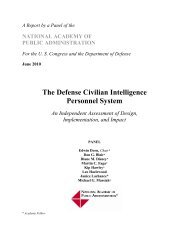Financial Management: Providing a Foundation for Transition - AGA
Financial Management: Providing a Foundation for Transition - AGA
Financial Management: Providing a Foundation for Transition - AGA
- No tags were found...
You also want an ePaper? Increase the reach of your titles
YUMPU automatically turns print PDFs into web optimized ePapers that Google loves.
11have worked under CRs in the past three years.About one in five has experienced CR-relatedproblems that have affected some aspect of theirentity’s program and mission. The reportedproblems include issues of program integrity,poor resource management, inability to plan,distraction from the core business of financialmanagement and wasteful incremental fundingof projects and contracts.Program integrity. Says an executive, “CRs hurtus the most in the area of program integrity,which is funded last in priority. Program integrityincludes risk management, facility maintenance,etc. In CRs, people abandon lookingat return on investment and do the immediatething, rather than what will be important in thelong term. If we are in the process of measuringsomething, we have to stop measuring <strong>for</strong> awhileand then return to it, with a lot of observationsand data lost in between.”Planning. “CRs lead to poor management ofresources, as managers are <strong>for</strong>ced to be reactive,rather than proactive,” says an executive. “Theycan’t plan ahead and start new projects. Whenfunding is received it is often too late in the yearto fully execute.”Distraction. “The CFO gets distracted and loses3 or more months in most CRs. This causesdelays and cutbacks and hinders the ability of theorganization to move <strong>for</strong>ward,” says an executive.Waste of time. “The problem with CRs isthat, after the process is started, you have todevelop a spend plan that needs to be approvedby the department, then by Congress, whichcan take up to 60 days,” says an executive, “Allthis time delay <strong>for</strong> a CR that can be as shortas 10 days. Better not to have CRs, but if wedo, then have CRs <strong>for</strong> an extended period of30 days or so.” In addition, CRs can causeincremental funding of contracts, which meansmore work <strong>for</strong> entity staff.Loss of quality. According to an executive,“Once a budget is approved, everything shiftsto the hurry-up and obligate mode—we losethe window of opportunity to provide qualityreviews of financial decisions because the rush toobligate doesn’t always allow it.”Everyone agrees CRs are inevitable, so planning<strong>for</strong> and dealing with these bills is critical.Most executives want OMB, the White Houseand Congress to accept responsibility <strong>for</strong> theiractions related to CRs and then agree to helpimprove the process of managing under acontinuing resolution. Here are some of theirstrategic and tactical suggestions <strong>for</strong> dealingwith continuing resolutions.Strategic actions. At a macro level, strategicimprovements all require coordination betweenthe White House, OMB and Congress. Thesestrategic improvements include:• Thirty-day (minimum) continuing resolutions.There is a pretense that somehow a2-day or 2-week CR will allow enough timeto work out the details to resolve an approvedbudget. In fact, the shorter-term CRs causetoo much anxiety on all fronts. A 30-day CRis a reasonable timeframe. Should a budget beapproved be<strong>for</strong>e 30 days, the budget becomesimmediately effective and supersedes the continuingresolution.• Biennial budget. This means giving everyfederal entity a 2-year appropriation. The topichas been discussed at various levels <strong>for</strong> morethan 20 years. This can be done in ways thatensure that legislators have a hand in shapingthe federal budget.













